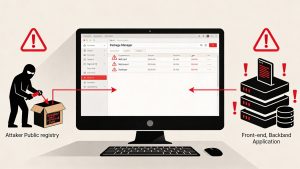Software teams must push code to users without breaking running services. Two professional disciplines shape that objective: DevOps and Site Reliability Engineering. Engineers weighing career paths often compare SRE vs DevOps to decide which skill set fits their goals. Recruiters want role clarity so that job descriptions attract the right talent. Hiring managers need a shared vocabulary before structuring teams. This article explains the work, traces the boundaries, and shows why the two practices reinforce each other.
What is DevOps?
DevOps grew from the idea that one team should write, test, deploy, and operate software. A single workflow shortens feedback loops because the same people who commit code also watch it in production. Continuous integration tools compile each change and run automated tests. Continuous delivery pipelines move built artifacts through staging into production. Infrastructure as Code lets teams version environments so that every server image matches repository state. Observability tools collect metrics, logs, and traces so that faults surface early. When new engineers join a DevOps group they write application code, adjust pipeline configuration, and respond to runtime incidents. The combination builds technical breadth and reinforces accountability for release quality.
What is Site Reliability Engineering (SRE)?
Site Reliability Engineering applies software engineering techniques to keep services available, responsive, and scalable. An SRE team defines indicators such as latency, throughput, and error rate. They set objectives that describe acceptable thresholds. The gap between perfect reliability and the objective becomes an error budget. Feature work continues while the budget remains, but rolls back or pauses when consumption rises. SRE engineers write automation that detects faults, pages responders, and triggers safe rollouts or reversions. They conduct post‑incident reviews that focus on system behaviors instead of individual mistakes. Over time, toil—manual work that does not improve the service gets automated away. The result is a platform that supports rapid change without prolonged outages.
Key Differences Between SRE and DevOps
The difference between SRE and DevOps rests on priority, measurement, and workflow. DevOps concentrates on speed. SRE concentrates on reliability. DevOps teams track deployment frequency, lead time, and change failure rate because those metrics expose flow efficiency. SRE teams track latency, availability, and error budget burn because those metrics expose user impact. DevOps pipelines run unit tests to prove functional correctness before promotion.
SRE guards production with automated rollbacks and circuit breakers that limit blast radius when unknown flaws appear. DevOps treats infrastructure as another component to version and ship. SRE treats infrastructure as a living system that needs constant observation. Because aims diverge, staff backgrounds differ. A DevOps engineer often starts as a developer who learns operations. A site reliability engineer often starts as a system specialist who learns software design. Yet each role has to understand enough of the other to communicate, which keeps silos low.
The second distinction appears in incident practice. DevOps engineers on call fix broken builds, pipeline errors, or configuration drift that blocks releases. SRE engineers on call respond to user‑visible degradation. They restore service, record timelines, and update runbooks. The handoff works because the SRE team trusts the pipeline, while the DevOps team trusts the monitoring. This separation helps large companies scale engineering without duplicating every skill set in each product squad.
A third dimension involves risk. DevOps sees risk in delayed feedback because unreleased code hides defects. SRE sees risk in uncontrolled change because untested traffic patterns stress systems. Risk sharing forms the bridge between both views. When DevOps introduces canary releases, they ask SRE to define traffic percentages. When SRE expands an error budget, they ask DevOps to verify tests that justify the budget. Collaboration keeps risk at an acceptable level rather than zero, which aligns with business deadlines.
These contrasts answer the frequent search query site reliability engineer vs DevOps and remove the perception that one role replaces the other.
How SRE and DevOps Complement Each Other
Integration starts with shared tooling. A deployment pipeline that tags every release with a version and commit hash feeds directly into monitoring dashboards that link metrics to code. DevOps owns the pipeline because they commit changes and need fast feedback. SRE consumes pipeline metadata because it speeds root‑cause analysis during incidents. The pipeline publishes events; the monitoring system ingests events; both teams gain visibility.
Next comes policy. DevOps wants continuous delivery. SRE wants controlled error budget spending. Together they write automation that gates promotions on both test pass rate and available budget. The release halts when either guard fails. This approach keeps human judgement focused on edge cases instead of routine decisions.
Finally, both teams share learning loops. After each incident, SRE leads the review and extracts system lessons. DevOps reads the notes and improves tests or deployment logic. After each major feature release, DevOps reports friction they met in the pipeline. SRE adjusts reliability targets if data supports the change. The loop aligns improvement work with user impact, which means budgets fund projects that matter instead of vanity upgrades.
Through these mechanisms, SRE vs DevOps becomes collaboration rather than overlap. The pipeline pushes change, and the reliability layer absorbs the shock.
When to Adopt DevOps, SRE, or Both
A single‑product startup cares about market fit more than five‑nines uptime. It should assign developers to DevOps duties. Simple infrastructure, modest traffic, and limited budgets make separate SRE roles unnecessary.
A growing company that serves paying customers faces contractual uptime promises. It should add an SRE unit once outages start affecting revenue. The unit writes automation, formalizes indicators, and sets objectives that match customer expectations.
A large enterprise with many services, regions, and compliance rules should run both functions from the outset. DevOps squads embedded in each product team keep releases moving. An SRE platform group supplies incident tooling, cross‑service indicators, and training. The structure prevents duplication and enforces uniform reliability standards.
Recruiters writing job posts should state whether the role focuses on delivery or reliability. Job seekers can then signal fit. That clarity stops the confusion captured in searches for site reliability engineer vs DevOps because each candidate knows which problems they are expected to solve.
Managers who transition staff should map existing strengths. A developer who writes deployment scripts and enjoys pipeline optimization can move into DevOps. A system t500_prod_administrator who writes monitoring hooks and enjoys tracing network faults can move into SRE. Career paths remain clear, and engineers pick tracks that match interests.
Conclusion
DevOps and Site Reliability Engineering share a purpose: shipping value to users without disruption. DevOps removes friction between write and run. SRE removes uncertainty after run begins. The two roles differ because each guards a distinct constraint, yet they integrate through shared data and automation. Teams that understand the difference between SRE and DevOps avoid unproductive turf debates. They allocate people to the right tasks, set expectations, and build systems that grow without collapse. Students gain direction for skill building. Recruiters gain precision in hiring. Organizations gain a delivery engine backed by a reliability shield. As long as code changes and users click, both roles remain essential.



